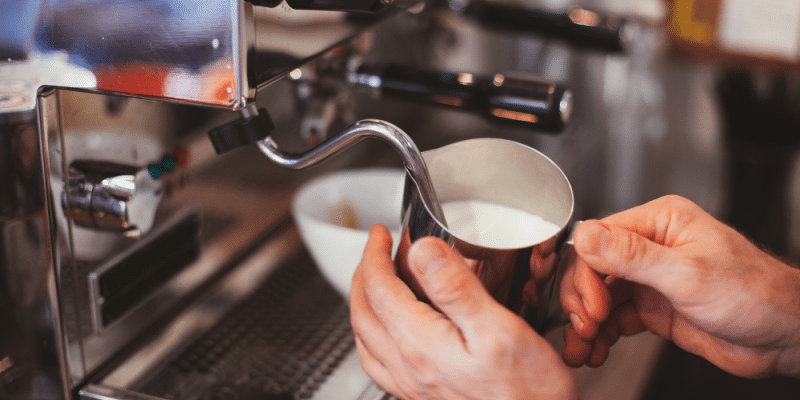Unconventional Milk Foaming: Rethinking Steam-Free Methods for Specialty Coffee
For both coffee enthusiasts and professionals, a meticulously textured milk-based Specialty Coffee, like a latte, flat white, or cappuccino, delivers an immensely satisfying sensory journey. While the essence of espresso significantly influences the drink’s quality, the milk’s steamed texture also holds undeniable importance.
Nonetheless, mastering the art of milk steaming proves to be a challenging endeavor, often requiring baristas months of practice to achieve proficiency. Interestingly, recent times have witnessed a surge in coffee shops and roasters embracing automated milk foaming solutions, driven by various compelling factors.
To delve deeper into the advantages of milk foaming, I had the privilege of conversing with Umberto Majer, President and CEO of VEA Ventures, and Jaime Gamoneda, Chief Commercial Officer at Heylo Coffee. Join me in exploring their valuable insights further.
Addressing the Difficulties Linked with Milk Steaming
“At first glance, milk steaming might seem like a straightforward procedure.
“Traditional milk steaming involves utilizing a steam wand,” explains Umberto. “This employs steam to both heat the milk to the desired temperature and generate a frothy, foamy texture.”
However, delving into the realm of milk steaming requires a grasp of its underlying scientific principles, as several crucial molecular transformations occur:
- As milk heats up, its proteins stretch and unwind.
- During the heating process, as we introduce air into the milk, the proteins envelop the air, forming bubbles.
- A milk protein possesses one end that is hydrophilic (attracted to water) and another end that is hydrophobic (repels water).
- Consequently, within each bubble, the hydrophilic end draws in the liquid while the hydrophobic end attracts the air. This dual interaction preserves the bubble’s structure, resulting in the formation of steadfast microfoam.”Inadequate Steam Handling Methods
Although this may seem straightforward enough, without following a number of best practices for steaming milk, a barista can end up with poor results in the cup. For example, if the wand tip is overly exposed or too far above the surface of the milk, it will force large bursts of air into the milk. This will create too much foam, resulting in an uneven texture.
Conversely, if the steam wind tip isn’t exposed enough and is too far below the surface, the milk will heat up, but there won’t be enough air introduced to the liquid. This will produce too little foam (also known as “wet” milk).
According to the Specialty Coffee Association, the recommended temperature to heat milk is 55°C to 65°C (139°F to 149°F). If a barista heats milk to a temperature above 70°C, they run the risk of denaturing the proteins, and thereby producing no microfoam.
“The difficulty with steaming milk traditionally is balancing time and the amount of steam and heat you introduce to the liquid, as well as getting the texture right,” Umberto tells me. “If you get it wrong, you could end up with watery, burned, or cold milk, or even too many or too little bubbles.”
The addition of water
Umberto clarifies that with conventional steaming techniques, approximately 10% to 15% of water resulting from the steam finds its way into the milk.
“Even with top-tier espresso machines, the lowest water addition hovers around 8%,” Jaime elaborates.
Consequently, this results in milk dilution, leading to a reduction in its creaminess and opulence. This not only undermines the overall consumer experience but also hampers the optimal outcomes achievable with espresso-based beverages.
Does Foaming Surpass Steaming?
Traditional espresso machines are vital in coffee establishments globally. Automation of milk steaming and foaming brings compelling advantages. Significant benefits arise from automating milk processes.
One of the most notable advantages revolves around milk conservation. Research conducted by the University of Edinburgh suggests that approximately one in six pints of milk produced in the UK is squandered or lost, with coffee shops accounting for a share of this wastage.
“When steaming milk, baristas often discard a small portion from the base of the pitcher due to it being either too ‘wet’ for latte art or due to an excess of milk being used,” explains Umberto. “In contrast, advanced automated milk foaming systems result in less than 1% milk wastage.
Reducing energy consumption
To generate steam as needed, an espresso machine’s boiler must be consistently operational and properly maintained. This not only translates to heightened energy expenses for a coffee enterprise but also exerts a notable ecological toll.
In contrast, milk foaming solutions utilizing induction thermal block technology, such as Helyo, demonstrate reduced energy consumption when compared to conventional machines. Consequently, this offers coffee shop owners the potential to curtail both their expenditures and environmental impact
Space and efficiency
Numerous milk foaming solutions come in modular formats, making them more compact than conventional espresso machines. This not only conserves countertop space but also bolsters workflow efficiency.
For instance, certain automated milk foaming systems possess the capability to froth various milk types, encompassing plant-based alternatives.
“Heylo’s Milk Module, by default, accommodates two milk types, with the potential to include another,” Jaime explains.
Umberto underscores the fact that distinct milk varieties necessitate diverse steaming approaches, complicating the task for baristas striving for consistent outcomes.
“Plant-based milks exhibit differing steaming behaviors,” he notes. “Some require lengthier steaming or higher air incorporation, while others demand lower temperatures, for instance.
“Furthermore, non-dairy milks possess a thinner consistency compared to cow’s milk, magnifying the risk of dilution,” he adds. “Employing an automatic milk foaming system can yield superior results.
Increasing adoption of automation
Unquestionably, a prominent trend within the coffee industry in 2023 is the burgeoning reliance on automation.
“Steaming doesn’t invariably contribute value,” states Umberto. “We stand at the precipice of a revolution in which automation will assume control over milk foaming.
“Ultimately, this shift will yield beverages of elevated quality, affording baristas more time to dedicate to crafting latte art,” he emphasizes.
Conversely, Jaime contends that steaming retains its significance in the realm of specialty coffee.
“Steaming milk and crafting latte art constitute integral facets of the barista profession,” he asserts. Nonetheless, he acknowledges that due to staffing limitations and escalating expenses, the role of automation within coffee shops is poised to expand further.
picture
The practice of milk steaming has held a longstanding role within the realm of specialty coffee, garnering affection from baristas across the globe. Nevertheless, in light of the escalating emphasis on beverage excellence, the quest for innovative drink preparation techniques gains significance.
A rising number of milk foaming solutions employing induction heating and alternative ‘steamless’ methodologies are surfacing in the market. Regardless of individual viewpoints, it’s inevitable that coffee shops will increasingly adopt these approaches in the days ahead.



